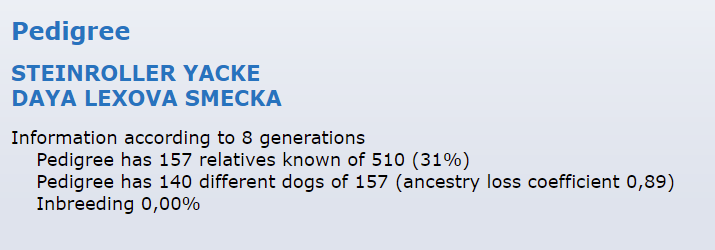Genetic diversity tools in the Finnish Kennel Club's breeding database
The idea for this post came during the discussions around our virtual International Dog Health Workshop on genetic diversity in May (see Ian Seath's great article about the workshop). We were discussing what kind of population statistics would breeders and breed clubs need, in order to take care of their breed population in a best possible way. I spoke to the group about the tools in the Finnish Kennel Club's breeding database, which elicited enthusiastic reactions.
The Finnish Kennel Club (FKC), as well as other Nordic kennel clubs, is well-advanced in analyzing data and making it available to breeders and breed clubs. Let’s make a short tour on the FKC breeding database and see what specific tools there are for breed-level genetic diversity.
The FKC advises to:
- avoid inbreeding especially in the first 5 generations (fast inbreeding) or keep this inbreeding coefficient (COI) below the breed average
- find individuals with rare alleles for breeding, and
- use as many dogs for breeding as possible, with as even number of offspring as possible.
Regarding the advise No 1. - calculating the COI for planned litters is possible using 4-8 generations data:

It gives you the pedigree and this info:

Regarding the advise No 2. - no mean kinships etc are available, so there's clear need for either pedigree-based or genetic tools for that. But males which not yet have registered progeny you can indeed find in the database, using different search criteria:
Regarding the advise No 3. - you can follow the numbers of litters and offspring per males and also per females:
Here the cumulative % is very useful, you can see that 10 males accounted for 29 % of all puppies registered during the chosen time period (now 2017-2022). Gipstern Ifender accounted for 4.46 % of puppies during that period. The columns 'Total' are all puppies, also those born outside the chosen period.
You can also rearrange this statistics by clicking on the underlined titles. At that point the cumulative % doesn't make sense anymore.
And you can click on the name of the dog, which brings you to the page where you can see the pedigree of the dog and the results of health and temperament tests, trials and shows, as well as Estimated breeding values and the list of siblings and offspring.
For monitoring, there are statistics by year and by generation (4 years):
- breeds' average COI ('Inbreeding' - this is calculated with as deep pedigrees as the data for each dog allows, but usually not reaching to the founders)
- N of different sires, dams and grandparents
-
ratio of sires/dams
- a figure describing the use of popular sires. If this is 1, there are no popular sires, as the use of males is as variable as possible.
- this breed is Hovawart, which is famous for its' good breeding practices, but there are breeds where this figure is as low as 0.30.
-
effective population size
- (should be calculated per generation, so the per year -figure doesn't tell you the right thing. Hopefully removed from the next version of the database.)
-
% of dogs used for breeding
- note that Hovawarts are not used at a young age so the percents are low here - they are going to grow in the future for these age classes.
And the good news is that most breeders / breed clubs know what to do with all this info. The FKC has a template for breed-specific breeding strategies (first version was developed in the beginning of 2000s) and has updated it a few times since then. The template walks you through on which information to include in the strategy and how to 'translate' it.
See the sections 4.1, 6.2 and 6.3: https://www.kennelliitto.fi/en/forms/breeding-strategy-jto-template-breeds-large-populations.
Thanks for reading!
In case you have questions, or want to share information on your own kennel club or breed club, please feel free to contact us at info@ipfdogs.com.
Read also my other blog post on how the FKC is promoting open studbooks and other important genetic diversity tools:
 Donate
Donate





0 Comments
Recommended Comments
There are no comments to display.